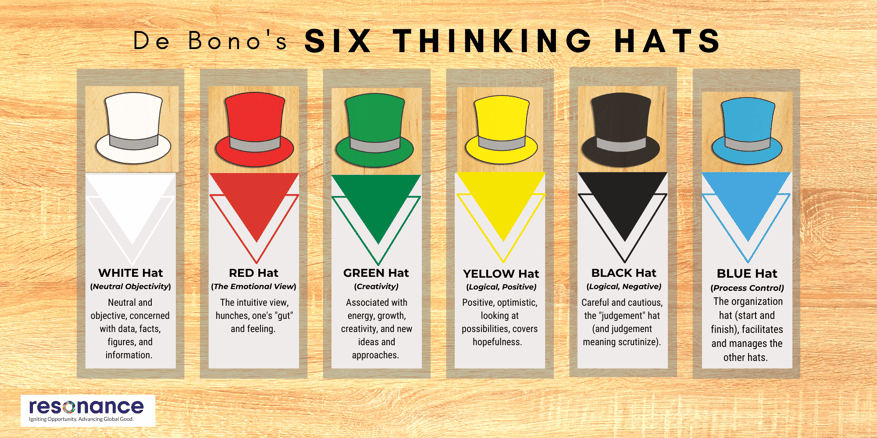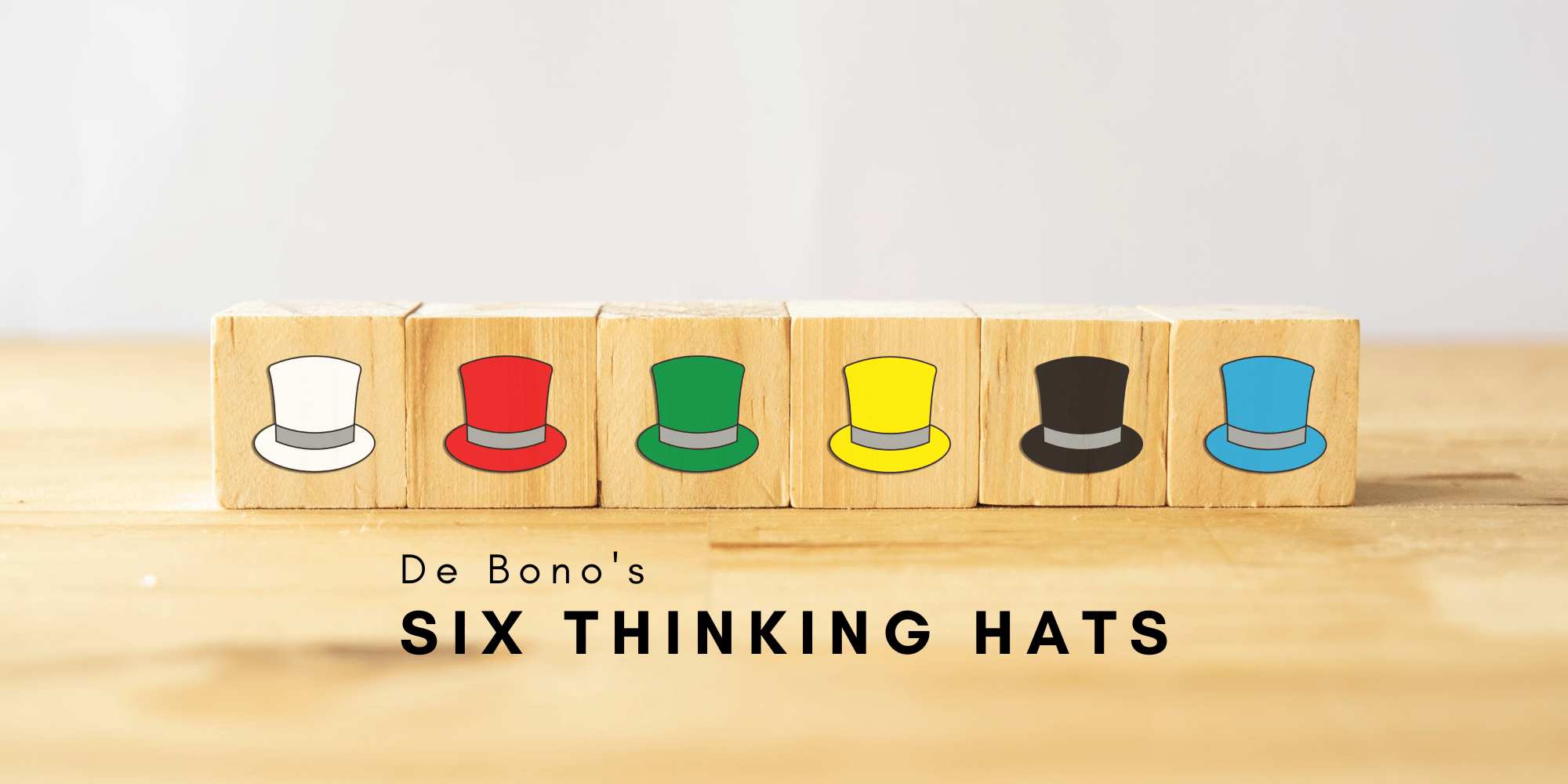There is an impressive array of tools for creative problem solving (CPS) that aid in both divergent thinking (generating ideas) and convergent thinking (analysis and decision tools) that are ideal for addressing challenges and opportunities, as well as central to change management approaches that accompany sustainability initiatives.
We have shared a few to date including widely used systemic approaches across programs and initiatives with tailored tools, such as Monitoring, Evaluation, and Learning (MEL) (central to work in global development and impact initiatives), as well as the ADKAR Model of Change, widely used in our work.
We also introduced a few lesser-known tools that can be applied to working with assembling teams to maximize innovation from ideation to final assessment, including the FourSight Innovation Tool. And we wrote recently about the Ladder of Abstraction tool, which is incredibly versatile in that it is both a divergent thinking tool in laddering up to generate creative ideas, and an exceptional approach to helping teams overcome barriers when they are stuck, laddering down by asking the challenge question, “Why, What’s Stopping You?”
Today we are talking hats. Six hats. De Bono’s Six Thinking Hats to be exact.
What are De Bono’s Six Thinking Hats?
The Six Thinking Hats framework was published in 1985, the conception and work of respected psychologist and Nobel Prize for Economics nominee Edward De Bono, creator of Lateral Thinking.
De Bono recognized that discussions in which people have different ideas and approaches can often lead to conflict. Conflict is not necessarily “bad,” as conflict can propel creativity; however, sometimes people and teams get stuck in that conflict stage of disagreement and cannot emerge with decisions or stall objective attainment. De Bono believed “Western” thinking and debate based on argumentation (where one person makes a claim or statement, and others challenge it), was often counter-productive.
He conceived of a better way to move through such stages of group ideation and deliberation with greater effectiveness using a lateral thinking process. While argument focuses on “what is,” parallel thinking looks at “what can be.”
De Bono’s six hats, each with a different color, immediately as a tool organizes thinking and discussions, eliminating confusion as everyone is looking in the same direction. The benefits include:
- focusing the discussion on oneaspect of the decision at a time, such as potential risks or possible benefits. It also encourages more expensive thinking, and
- preventing people and teams from getting boxed into only looking at a challenge or opportunity through one lens.

The six hats in De Bono’s approach include:
- The white hat: This is the objective hat, which focuses on facts and logic
- The red hat: This is the intuitive hat, focusing on emotion and instinct
- The black hat: This is the cautious hat, used to predict negative outcomes
- The yellow hat: This is the optimistic hat, used to look for positive outcomes
- The green hat: This is the creative hat, where ideas are abundant and criticism spare
- The blue hat: This is the hat of control, used for management and organization
Application of the Six Thinking Hats
There are many applications of De Bono’s Six Thinking hats approach, detailed not only in his book as examples, but also in case studies and mentioned in published blogs and articles. We highlight here a few illustrations to demonstrate the versatility of the approach.
New Product, Service, and Initiative Ideation
The Six Thinking Hats framework has been widely used to generate new products, services, and opportunities. It is an ideal approach for brainstorming sessions where you need to cover all the bases and possibilities with depth.
- One widely-published case study frequently cited details the ways in which the hat approach helped 3M create a new line of Duct Tape to tap a growing market that included a variety of project uses beyond construction: women. Today, you can find rolls of pink, pink camo and even glitter Duct Tape on the shelves and online.
Case-Based Learning and Improvement Training
Much of the reported use of De Bono is from a training perspective in formal educational and corporate settings and how it works in facilitation of better outcomes and objective attainment. Trainings that center real cases in which participants view scenarios through different lenses, or hats, can lead to collaborative learning and performance improvement.
- A colleague certified in Six Thinking Hats facilitation utilized the approach as part of a debrief training in a hospital network, using a real scenario they experienced in which a series of decisions and interactions with a patient and his family led to not only filed complaints, but also negative publicity in the community, and dings on the hospital’s quality indicators and scores. Training asked participants to view what happened through various hats to gain additional context, perspective, and potential best practices. The outcomes contributed to revised policies and additional trainings to improve patient interaction and service.
Evaluation of Strategic Plans and Options
De Bono’s Six Thinking Hats can also be used in analysis of strategic choices where ideas and options on the table should be explored more holistically, and with attentiveness to not only creative ideation, but also finding shared language and examining multiple perspectives and associated feelings.
- NASA is one organization that has utilized De Bono’s Six Thinking facilitation and training many times over the years. One recent application of the framework was featured in an article published in the journal, Biomimicry for Aerospace. For those new to the concept of biomimicry, it is the design and production of materials, structures, and systems that are modeled on biological entities and processes, in other words, emulating nature’s fundamental strategies for use in human-made products.
In this case, the Six Thinking Hats approach was used at NASA’s Virtual Interchange for Nature-inspired Exploration (V.I.N.E.) workshop to explore existing and emergent tools and methods in Biomimicry In Design (BID). More broadly, the workshop sought to contribute to the establishment of a “standard of practice” for BID use in systems engineering, design, and engineering, and to develop a workflow of both tangible next steps and long-term vision and aspirations as they relate to advancing this standard of practice.
De Bono’s Hats in Environmental Contexts
There have been several examples of the use of De Bono’s Six Thinking Hats, particularly in the 1990s-2000s, centered on resolving conflict in environmental decision-making. This includes its then recommended use in ongoing Great Lakes nearshore water governance, for example, and more recently, coastal resiliency planning. This is not surprising given De Bono’s published book, Conflicts: A Better Way to Resolve Them, in which he saw tremendous potential for the use of lateral thinking and a multi-hat approach.
Although there are few published cases of the use of De Bono’s Six Thinking Hats in global development and sustainable impact contexts, there does appear to be some momentum in its recommended and actual use, which is exciting given its effectiveness in business and organizational environments.
This includes the NASA workshop example described above, which resulted in a decision by the group to center as part of a 20+-year vision the core facet of biomimicry in seeking environmentally sustainable solutions to design challenges. This was a paramount consideration among others in mapping out the future of NASA’s BID pursuits.
It also includes the use of De Bono’s Six Thinking Hats approach to generate creative thinking around the role of procurement as a competitive advantage in the context of the circular economy. Not only did the process prioritize the introduction of more sustainable inputs and products, but it also recommended that in the transition to circular economy concepts, a quality control procedures and manufacturing standards should be prioritized.
These outcomes demonstrate how the donning of different hats in lateral thinking can both contribute to creative ideas (green hat with others), but also necessary cation (black hat with others) in analysis as well.
How Might We Use De Bono’s Six Thinking Hats in Partnership Work and Sustainability?
Given the effectiveness of De Bono’s Six Thinking Hats in broad application in business and organizational contexts since it was first introduced, those of us familiar with its use can perhaps imagine immense potential to utilize this lateral thinking approach in sustainability and partnership work.
- For example, facilitated use of the white and red hats could help illuminate stakeholder goals and expectations in a robust cross sector partnership, helping to further identify intersections where collaboration is more ideal than working it alone.
- The yellow and green hats could aid partners in identifying an array of creative ideas and strategies that might not be conventional or obvious – the kind of innovative approaches in technology, financing, and empowered and inclusive capacity building that are believed necessary in finding solutions to wicked problems at the nexus of climate change and biodiversity.
- Centering the black hat could identify potential obstacles that complex partnerships might encounter along the way, helping groups proactively plan, including identifying alternatives.
- The use of multiple-hats could through analysis and attentiveness to each partner help a stymied partnership get unstuck, pivot, and generate new ideas, such as adding new and different partners, or even dissolving if the partnership has run its course.
- In work with private sector clients engaging in ESG, Scope and Sustainability work, De Bono’s lateral thinking approach might help organizational and supply chain stakeholders find common purpose and shared language to increase buy-in and improve collaboration.
- The tool could also be useful in helping businesses identify and dissolve barriers that are stalling roadmap implementation. For stakeholders reluctant to operationalize new approaches in their day-to-day, the use the yellow hat may be ideal in helping them focus on the possibilities, rather than the fear associated with change.
These are just a few challenges in sustainability and partnership work that De Bono’s Six Thinking Hat framework might be a useful tool. With good facilitation and a dedicated blue hat, whether it be internal or with a consultant, teams can creative problem solve by approaching the challenge or opportunity with a different perspective, yielding sometimes unexpected, but impactful results.
They may only be hats and not a cape, but this tooled approach can be a superhero.
There are many resources in the way of articles, blogs, and videos available to learn more about De Bono’s work and his Six Thinking Hats. We suggest you start with the organizations he founded including De Bono, and the De Bono Group, that include resources on his research, publishing, facilitative work and extended faciltiator network.



